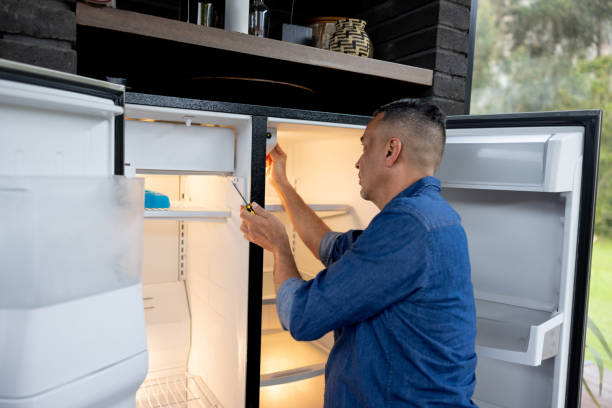Keep Your Refrigerator Running Smoothly: A Guide to Maintaining and Replacing Refrigerator Door Seals

refrigerator maintenance
Introduction
In the heart of your kitchen stands a silent hero – your refrigerator. It tirelessly keeps your food fresh and your drinks cold. But to ensure it continues to do its job efficiently, regular maintenance is crucial. One often overlooked yet vital component of your refrigerator is the door seal. In this guide, we’ll explore why maintaining and replacing your refrigerator door seal is important and provide you with easy steps to keep your fridge running smoothly.
Why Is the Refrigerator Door Seal Important?
The door seal, also known as the gasket, is the rubber strip that lines the perimeter of your refrigerator and freezer doors. Its primary function is to create an airtight seal when the doors are closed, preventing cold air from escaping and warm air from entering. Here’s why it’s essential to keep this seal in good condition:
- Energy Efficiency: A worn-out or damaged door seal can cause your refrigerator to work harder to maintain the desired temperature, leading to increased energy consumption and higher utility bills.
- Food Preservation: A properly sealed door ensures consistent temperature levels inside the refrigerator, preserving the freshness and quality of your food items.
- Preventing Frost Build-Up: A faulty door seal can allow excess moisture to enter the refrigerator, leading to frost build-up and potentially damaging internal components.
Signs Your Refrigerator Door Seal Needs Attention
Before diving into maintenance and replacement, it’s essential to recognize the signs indicating that your refrigerator door seal may need attention:
- Visible Damage: Check for cracks, tears, or visible wear on the rubber gasket.
- Poor Seal: If you notice condensation forming on the exterior of the refrigerator or if the doors don’t close securely, it could indicate a faulty seal.
- Increased Energy Bills: A sudden spike in energy bills without any other obvious cause may indicate that your refrigerator is working harder than usual, possibly due to a compromised door seal.
Maintaining Your Refrigerator Door Seal
Regular refrigerator maintenance can extend the lifespan of your refrigerator door seal and ensure optimal performance. Here are some simple steps you can take to keep it in top condition:
- Cleaning: Wipe the door seal regularly with a mild detergent and water solution to remove dirt, grease, and food residue. Be sure to dry it thoroughly to prevent mold and mildew growth.
- Avoiding Overstuffing: Overfilling your refrigerator can put strain on the door seal, causing it to warp or wear out faster. Keep the contents organized and avoid blocking the seal with items stored inside the fridge.
- Check for Proper Alignment: Periodically inspect the alignment of the refrigerator doors to ensure they close tightly and the seal makes full contact with the appliance’s frame. Adjust the door hinges if necessary to improve alignment.
How to Replace a Refrigerator Door Seal
If your refrigerator door seal is damaged beyond repair or no longer provides a tight seal, it may be time for a replacement. While this task may seem daunting, with the right tools and guidance, you can easily replace the door seal yourself. Here’s a step-by-step guide:
- Purchase the Correct Replacement Seal: Before you begin, make sure to purchase the appropriate replacement door seal for your refrigerator model. You can find compatible seals online or at appliance stores.
- Prepare the Refrigerator: Start by unplugging the refrigerator to ensure your safety. Remove any items stored on the door shelves and clear the area around the door to allow easy access.
- Remove the Old Seal: Carefully peel off the old door seal from the refrigerator door, starting from one corner and gradually working your way around. Use a putty knife or a similar tool to help loosen the seal if needed.
- Clean the Surface: Once the old seal is removed, clean the surface of the door where the new seal will be installed. Wipe it down with a mild detergent and water solution to remove any dirt or residue.
- Install the New Seal: Begin by aligning the new door seal with the refrigerator door, starting at one corner. Press firmly to ensure it adheres securely to the door surface. Continue pressing along the entire perimeter until the seal is fully installed.
- Allow for Proper Seating: Close the refrigerator door gently to allow the new seal to settle into place. Check for any gaps or areas where the seal may not be making full contact with the door frame.
- Test the Seal: Once the new seal is installed, plug in the refrigerator and wait for it to reach the desired temperature. Check for any signs of air leakage or condensation around the door to ensure the seal is functioning correctly.
- Monitor Performance: Keep an eye on your refrigerator’s performance in the following days to ensure the new seal is effectively maintaining the temperature and preventing energy loss.
By following these simple steps, you can replace the refrigerator door seal and keep your appliance running efficiently for years to come.
Conclusion
Your refrigerator works hard day in and day out to keep your food fresh and your drinks cold. By giving it the attention it deserves through regular maintenance and timely replacement of components like the door seal, you can extend its lifespan and maximize its efficiency. With the easy-to-follow tips provided in this guide, you can ensure that your refrigerator continues to be the reliable appliance you rely on in your kitchen. So, take the time to care for your refrigerator, and it will continue to serve you well for years to come.








